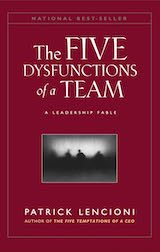“The Five Dysfunctions Of A Team” is a small book by Patrick Lencioni on how to create effective teams. The author presents insights gleaned from having worked with various CEOs and having coached them on how to build such teams for their respective companies. There are some nifty insights for leaders in this book.
The author claims that teamwork is elusive because most teams fall prey to five dysfunctions. These dysfunctions are inter-related issues, where one issue leads to another. The author illustrates this model with a pyramid, where the most fundamental issue is at the base of the pyramid and the final issue is at the top.
In an interesting approach, the author presents a parable in the first part of the book to illustrate their ideas and then presents their model in the second part of the book. The parable takes up quite a big portion of the book, but I found it helpful (if a bit contrived). The parable revolves around a fictional technology company that is struggling, so the board hires an external CEO to fix it, in the process pulling her out of her early retirement. The new CEO just observes the workings of the company for a while and then organizes a series of off-site retreats for her executive team to drill these ideas into them. It is a difficult transition for the team and it does not emerge unscathed at the end of it. I found it interesting that the CEO is shown having self-doubt and having to take tough decisions with individuals in the larger interests of the company.
In the model presented by the author, the issues (starting from the base) are:
- An absence of trust in the team because they are unwilling to be vulnerable in front of each other, presenting a facade of invulnerability instead.
- This leads to a fear of conflict, so teammates avoid having unfiltered debates based on ideas (and not personalities), choosing instead to be guarded during discussions.
- This in turn leads to a lack of commitment in the team and there is no buy-in for decisions and plans of action as team-members feel that they have not been able to express their honest opinions.
- That results in a lack of accountability and teammates hesitate to call out their peers on their execution.
- That breeds a culture of inattention to results for the team and team-members end up placing their individual goals before the outcomes for the team as a whole.
After presenting the model, the author presents a quick diagnostic to help you evaluate your own team, in the form of a set of questions (that you can also ask your teammates to answer) and a scoring methodology. This diagnostic should help you identify which kinds of issues your team suffers from. The author admits that solving these issues take quite a lot of discipline and suggests a few ways in which teams can approach resolving these issues.
I found the ideas presented here intriguing, but I am a bit skeptical about the model itself. These are definitely issues that I have seen in various teams, but these are not the only issues that I have seen. The number of issues here seem to have been selected to match the title of another book by the author and both seem to have a suspiciously pleasant and small number in their respective models (like almost all self-help books). I am not saying this to dismiss these ideas, but merely to wonder if these really are the elemental issues in teamwork and whether they really are inter-linked in the manner presented by the author here. In any case, this book presents good fodder for thought and for action.
If you are a leader, read this book and reflect on the ideas presented here based on your experience and the state of your team. It is a short book, so it would not take up that much of your time. It would be interesting to see how many teams have been helped by applying these ideas and how many could not.
